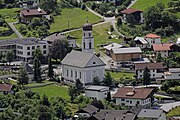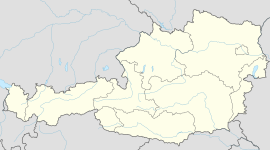
Imst is a town in the Austrian federal state of Tyrol. It lies on the River Inn in western Tyrol, some 50 kilometres west of Innsbruck and at an altitude of 828 metres above sea level. With a current population (2018) of 10,504, Imst is the administrative centre of Imst District.

Wildermieming is a municipality in the district of Innsbruck-Land in the Austrian state of Tyrol located 40 km west of Innsbruck and 4 km west of Telfs. The village was separated from Mieming which belongs to Imst (district) in 1833 and was incorporated into Innsbruck-Land in 1925.

Gramais is a municipality of 41 inhabitants in the district of Reutte in the Austrian state of Tyrol. The municipality is located in the district court Reutte. It is the smallest municipality in Austria.

Haiming is a municipality and the name of its largest town, located in the district of Imst in the Austrian state of Tyrol.

Imsterberg is a municipality and a town in the district of Imst located 4.4 kilometres (2.7 mi) west of Imst.

Jerzens is a municipality and a village in the district of Imst (district) and is located 8 km south of Imst at the Pitze River in the valley with the same name. Settlement of the area began around 600. The village was mentioned in a register in 1313 for the first time. Jerzens has 1008 inhabitants and its main source of income is agriculture and tourism.

Wenns is a municipality in the Imst district 7.30 km south of Imst at the Pitze river. Due to its central location in the Pitztal valley it is one of the area's key villages. The primary source of income is tourism, especially skiing even though there is no skiing in Wenns itself. The 700-year-old Stamserhaus in Wenns is the oldest farmhouse in Tyrol.

Tarrenz is a municipality in the Imst district and is located 3.60 km north of Imst at the lower course of the Gurgl brook. The village is an agriculture community with emphasis in sheep breeding and a settlement for commuters. In the last years Tarrenz was able to increase its economy and also to beautify the picture of the village. It has 2785 inhabitants (01.01.2022).

Sankt Leonhard im Pitztal is a municipality in the Imst district, located 20 kilometres (12 mi) south of Imst on the upper course of the Pitze River in western Austria. The village covers a large area and has a length of around 25 kilometres (16 mi). It is one of the biggest communities of Tyrol by area.

Roppen is a municipality in the Imst district and is located 5 km southeast of Imst between the mouths of the Pitze River and the Ötztaler Ache. The village was mentioned in documents in 1260 for the first time as "Roupen" but settlement already began 3000 years ago.

For the musician, see Julius Rietz.

Karres is a municipality and a village in the district of Imst in Austria and is located 2.5 km east of Imst near the mouth of the Pitze River. The village was founded in the Middle Ages because of mining. It has 589 inhabitants.

Karrösten is a municipality and a village in the district of Imst, located 1.3 km east of Imst. The village was founded because of mining in the 16th century. Fruits and maize as well as sweet chestnuts flourish on the slopes.

Längenfeld is a municipality and a village the Imst (district) and is located 25 km southeast of Imst in the Ötztal valley, 14 km north of Sölden.

Mieming is a municipality in the Imst district and is located 19 km east of Imst and 6 km west of Telfs. Main sources of income are agriculture and Summer tourism.

Mils bei Imst is a municipality in the Imst district and is located 5 km west of Imst. Thanks to a motorway tunnel the location is free of heavy traffic. Mils possesses a flood-meadow which is a popular recreation area.

Mötz is a municipality and a village in the Imst district, located 16.30 km east of Imst and 9 km west of Telfs. The first mention of the village dates back to the 12th century. Once connected with Mieming, Mötz became an own municipality after World War II. Main sources of income are agriculture, summer tourism but Mötz is also a typical residential area.

Nassereith is a municipality and a village in the Imst district in Tyrol, Austria and is located 11 km north of Imst on the upper course of the Gurgl brook. The village was mentioned in documents for the first time in 1150 but settlement had already began 200-300BC. The main source of income is tourism but Nassereith is now also a community for commuters.

Obsteig is a municipality in the Imst district and is located 15 km northeast of Imst and 3 km above Mötz. The village has 14 parts and is a popular area for skiing. Main sources of income is Winter tourism.

Silz is a municipality in Austria in the Imst district. It is located 15 kilometres (9.3 mi) east of Imst and 11 kilometres (6.8 mi) west of Telfs. The ski resort Kühtai administratively belongs to the village area. Besides winter tourism, summer tourism, especially rafting on the Inn River, is also an important source of income for Silz.
























